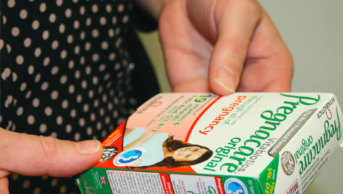This content was published in 2014. We do not recommend that you take any clinical decisions based on this information without first ensuring you have checked the latest guidance.
The use of mouthwashes in regular oral hygiene and the management of oral conditions continues to gain popularity. The most recent UK Adult Dental Health Survey suggests that mouthwashes are most commonly used by younger adults,1 but adults of all ages may benefit from them.
The range of mouthwashes can, however, be bewildering to an individual who is simply encouraged “to start using a mouthwash”, be it by a healthcare professional or friend.
Types of mouthwash
Mouthwashes can be classified under three main types: antiseptic, plaque-inhibiting, and preventive. Because most offer a range of overlapping benefits, the classifications in this article relates to their primary purpose[1].
Whatever the primary purpose and added benefits of a mouthwash, they all — to a greater or lesser extent — complement oral hygiene measures and give users a feeling of mouth freshness. It is important to recognise and remind patients that, currently, no mouthwash is a substitute for routine oral hygiene measures, which should be based on the twice-daily use of a toothbrush and fluoride-containing toothpaste, together with some form of interdental cleaning. Moreover, the excessive use of mouthwashes may have detrimental effects.
Antiseptic mouthwashes
Chlorhexidine-containing mouthwashes with a concentration of =0.2 per cent are one of the most commonly prescribed antiseptics in oral healthcare. They have long been considered to be a gold standard among oral antiseptic mouthwashes, acting on bacteria, spores and fungi.
The greatest benefit is obtained from the use of such mouthwashes as a short-term adjunct or as an alternative to regular oral hygiene procedures when the bacterial load in a surgical site cannot be reduced by other means or when brushing is difficult[2], for instance, immediately following oral surgery and the placement of sutures. Chlorhexidine mouthwash is often, therefore prescribed peri-operatively or post-operatively.
Chlorhexidine mouthwashes are also used in the immediate management of oral ulceration and erosive mucosal conditions to prevent secondary infection, which may delay healing, and in the oral care of patients with learning difficulties or a physical disability who are unable to practise adequate daily oral hygiene. They may also be used to manage severe halitosis associated with the extensive colonisation of sulphur-releasing bacteria on the dorsal surface of the posterior third of the tongue.
Chlorhexidine-containing mouthwashes also have special applications, for example, in the prevention of ventilator-associated pneumonia — one of the most common and life-threatening complications in patients on long-term intubation[3].
Mouthwashes containing =0.2 per cent chlorhexidine are normally prescribed to be used in 10–15ml amounts (often measured in the mouthwash bottle cap) for about 30 seconds, twice daily, for two weeks to one month. They are best used at least five minutes after toothbrushing. As long as all excess toothpaste has been spat out — in accordance with the oral hygiene maxim of “spit don’t rinse” — any residual toothpaste remaining five or more minutes after toothbrushing will not adversely affect the action of the chlorhexidine.
The common side effects of using a chlorhexidine-containing mouthwash include stubborn brown staining of teeth and oral appliances, including dentures, increased formation of tartar (calculus), temporary alteration to taste (dysgeusia), oral dryness and a sensation of burning of the oral mucosa, which typically resolves when use is discontinued.
Occasionally, a chlorhexidine-containing mouthwash may cause erythematous and desquamative lesions of the oral mucosa and use should be stopped. A claim last week that the use of a 0.2 per cent chlorhexidine-containing mouthwash may elevate blood pressure and increase the risk of heart attack and stroke stems from a small, single study that has been reported in the national press. Cardiovascular side effects have not previously been reported in the extensive literature pertaining to 0.2 per cent chlorhexidine-containing mouthwashes. The advantages of using a 0.2 per cent chlorhexidine-containing mouthwash, for a short period and according to directions, may continue to be found to outweigh greatly the recognised and the recently suggested, unsubstantiated side effects.
It has been reported that 0.12 per cent chlorhexidine mouthwashes produce relatively few side effects, but to maintain efficacy they may sometimes contain other agents, such as the quaternary ammonium compound cetylpyridinium chloride[4].
Given that chlorhexidine is poorly absorbed through mucosa, the probability of it reaching a fetus or being present in breast milk is low.
Plaque-inhibiting mouthwashes
Plaque is a biofilm formed by colonising bacteria. Plaque-inhibiting mouthwashes include a variety of active ingredients, ranging from antimicrobials (eg, cetylpyridinium chloride) and agents to prevent bacteria adhering to tooth surfaces (eg, the amine alcohol delmopinol hydrochloride) to essential oils (eg, thymol, eucalyptol, and menthol together with methyl salicylate).
As stated, benefits may extend to preventive and aesthetic effects but the active ingredients in plaque-inhibiting mouthwashes exert effects on oral plaque biofilm at different stages of colonisation, helping to control the onset and progression of gum disease and contributing to a reduction in tooth decay (caries).
The mechanisms by which plaque inhibiting mouthwashes act can be complex[5]. Quaternary ammonium compounds have a broad antibacterial spectrum of activity and destroy yeasts. Amine alcohols, such as delmopinol hydrochloride, while having little, if any, effect on plaque bacteria interact with constituents of tooth pellicle (the organic film which forms quickly on clean tooth surfaces) and inhibits glucan production by bacteria seeking to attach to the pellicle.
The actions of essential oils, which are capable of penetrating the plaque biofilm, include the disruption of bacterial cell walls, the precipitation of cell proteins and the inhibition of bacterial enzymes. Other agents in mouthwashes include triclosan, a bisphenol, non-ionic germicide that has a broad spectrum of activity against bacteria and fungi through blocking lipid synthesis. These mechanisms of action along with those of other ingredients often found in mouthwashes are summarised in the Panel.
| Ingredient | Action |
| Cetylpyridinium chloride | Antibacterial action |
| Delmopinol hydrochloride | Interacts with tooth pellicle constituents and inhibits bacteria seeking to attach to it |
| Essential oils (eg, thymol, eucalyptol, menthol) | Bacteriostatic which masks sulphides responsible for halitosis |
| Heavy metal salts (eg,zinc chloride, tin fluoride) | Reported to inhibit the growth of dental plaque and impeded tartar formation |
| Lysozyme | Enzymatic attack of bacterial cell walls |
| Sanguinarine* | Suppresses bacterial enzymes |
| Sodium benzoate | Alters glycolytic potential of plaque |
| Sodium bicarbonate | Antiseptic with capacity to neutralise acids in the mouth |
| Sodium chloride | Loosens oral debris and limited freshening effect |
| Triclosan | Antibacterial and antifungal activity by blocking liquid synthesis |
| *Extract of the bloodroot plant (Sanguinaria candensis) |
Plaque-inhibiting mouthwashes are intended to be an adjunct to routine oral hygiene procedures. If used as a sole means of hygiene their beneficial effects are limited. They are typically recommended for routine use, ideally twice a day, following thorough brushing and careful interdental cleaning.
The use of a plaque-inhibiting mouthwash immediately following brushing may reduce the effects of fluoride in toothpaste but such use may be appropriate if the immediate needs of the patient are improvements in plaque control, rather than the prevention of caries. Otherwise, using the mouthwash at times different from tooth brushing may best achieve the benefits of both the mouthwash and fluoride in toothpaste. Plaque-inhibiting mouthwashes may provide some benefits, albeit relatively limited, when used in the middle of the day, when it is not possible to perform any other form of oral hygiene procedure after eating.
Although manufacturers might claim advantages in levels of effectiveness of plaque-inhibiting mouthwashes, the benefit to the user may be as much down to compliance with the directions for use, which, it is suggested, may be related to an individual’s like or dislike of the flavour and sensation of the mouthwash, and the thoroughness of the associated routine oral hygiene procedures.
These mouthwashes, unlike antiseptic mouthwashes, notably chlorhexidine mouthwashes, are intended for ongoing rather than relatively short-term use. Given that the excessive consumption of alcohol, in particular when linked to smoking, is recognised as a major risk factor for mouth cancer, a possible link between the long-term use of alcohol-containing, plaque-inhibiting mouthwashes and mouth cancer has been the subject of numerous investigations.
A recent meta-analysis is considered to counter any concerns that the regular, let alone irregular use of alcohol-based mouthwashes may increase the risk of mouth cancer[6]. Mouthwashes containing alcohol and essential oils are among the most widely used and are associated with a good, ongoing level of consumer satisfaction. However, alcohol-free mouthwashes are available for individuals who wish to limit or avoid exposure to alcohol for various reasons.
Plaque-inhibiting mouthwashes tend to cause fewer side effects than antiseptic ones. Some users, especially those with an underlying condition such as dry mouth (xerostomia), may report mild dysgeusia and tingling of the mucosa. The inconvenience caused by these possible side effects is frequently considered to be outweighed by the enhanced sensory “mouth feel”. Allergic reactions are rare.
Plaque-inhibiting mouthwashes are good at giving users an agreeable feeling of mouth freshness but they have not been found to be effective as a sole means of controlling bad breath.
Preventive mouthwashes
Of the mouthwashes with a primary preventive effect, the most widely used are those containing fluoride, to help prevent tooth decay and, in some cases, aid the reversal of early lesions of caries.
A fluoride mouthwash or mouthrinse may be recommended or prescribed for patients aged eight years or over and who are at higher risk of developing dental caries.1 Individuals with a high risk of dental caries include people with a frequent sugar intake or xerostomia, or undergoing orthodontic treatment because the presence of a fixed appliance may compromise ability to maintain optimum oral hygiene. There is some evidence that a daily fluoride mouthrinse will reduce the risk of tooth decay during treatment with fixed braces[7].
There are two main options: daily fluoride rinses (0.05 per cent sodium fluoride) or weekly rinses of a higher strength (0.2 per cent sodium fluoride). Both have been shown to reduce dental caries progression in children[8]. It is always recommended that these products are used as an adjunct to twice daily brushing with a toothpaste containing at least 1,350ppm fluoride and, where appropriate, interdental cleaning.1 In all cases, unless specified differently in the manufacturer’s directions for use, these washes and rinses should be used for one minute and then spat out.
Best practice guidelines now suggest that they should be used at different times to toothbrushing1 — an approach which may seem strange at first to patients, but improves effectiveness. And, to further maximise effectiveness, patients should be advised not to eat, drink or rinse their mouth for 30 minutes after rinsing[9].
As with plaque-inhibiting mouthwashes, side effects and adverse reactions to preventive mouthwashes tend to be mild and rare assuming the user complies with directions for use, in particular to spit rather than swallow.
Other mouthwashes
To complete the picture, some mouthwashes may be intended for managing specific conditions, such as xerostomia, which may be an effect of some drugs, radiotherapy or autoimmune disease. Management of a dry mouth depends on preference. There is little evidence that one lubricating mouthwash is more effective than another topical therapy[10].
Mouthwashes may also be used to manage dentine hypersensitivity — the short, sharp pain many individuals suffer when they subject exposed dentine to a stimulus such as cold from an iced drink. However, thermal sensitivity may also be the sign of disease requiring active treatment. A dentine hypersensitivity mouthwash should not be used long-term without consulting a dentist.
Finally, tooth-whitening mouthwashes have become popular over-the-counter products. The active ingredient in these products tends to be either hydrogen peroxide or carbamide peroxide[11]. The main effect of these mouthwashes may be to bleach surface stains on teeth, as distinct to the whitening of tooth structures as achieved by professionally prescribed tooth bleaching systems. Users of tooth-whitening mouthwashes should be aware of the possible side effects, including tooth sensitivity and gum irritation. Limited information is available on the long-term use of these products.
What the British Dental Association says
The British Dental Association’s position on mouthwashes is as follows:[12] “Systematic reviews of the efficacy and outcomes of mouthwash use indicate that certain mouthwashes provide some additional benefit to plaque and gingivitis reduction when used in addition to brushing and the use of interdental oral hygiene aids and techniques, including flossing. Patients should discuss with their dentist which mouthwashes are suitable for use as part of their oral hygiene cleaning measures. Alcohol-containing mouthwashes may pose ethical and cultural issues for some populations and age groups. In all cases, mouthwashes should be used according to the manufacturer’s directions to minimise possible side effects on, for example, certain forms of tooth-coloured restorations (fillings).”
This patient
When recommending that a patient start using a mouthwash, a dentist would normally advise on the type of mouthwash to select and the rationale for its use. If the reason is unclear, the patient should be advised to contact the dental practice. If this patient is clear as to the reason for having been recommended to start using a mouthwash or rinse, he or she may be directed to appropriate over-the-counter antiseptic, plaque-inhibiting or preventive products.
Given the range of products available and the differences in composition, taste and “mouth feel”, it may be helpful to suggest the purchase of one or more of the travel-size bottles of mouthwash that are increasingly available, initially, so the patient can find a personal preference. Patients’ choices may be influenced by additional possible benefits from the use of a mouthwash, such as tooth whitening.
The infographic summarises the mouthwash categories by clinical recommendation, purpose and active ingredient.

References
- Departments of Health and British Association for the Study of Community Dentistry. Delivering better oral health: An evidence-based toolkit for prevention. London: Department of Health and British Association for the Study of Community Dentistry, 2009.
- Varoni E, Tarce M, Lodi G et al. Chlorhexidine (CHX) in dentistry: state of the art. Minerva Stomatologica. 2012;61:399-419.
- Linden GJ & Herzberg MC. Periodontitis and systemic diseases: a record of discussions of working group 4 of the Joint EFP/AAP Workshop on Periodontitis and Systemic Diseases.Journal of Clinical Periodontology. 2013 (Suppl 14): S20-23.
- Van Strydonck DA, Timmerman MF, van der Velden U et al. Plaque inhibition of two commercially available chlorhexidine mouthrinses. Journal of Clinical Periodontology. 2005;32:305-9.
- Barnet ML. The rationale for the daily use of an antimicrobial mouthrinse. J. AM Dent Assoc. 2006;137(suppl):16s–21s.
- Gandini S, Negri E , Boffetta P et al. Mouthwash and oral cancer risk – quantitative meta-analysis of epidemiologic studies. Annals of Agricultural and Environmental Medicine. 2012; 19: 173-180
- Benson PE, Parkin N, Millett TD et al. Fluorides for the prevention of white spots on teeth during fixed brace treatment. Cochrane Database of Systematic Reviews. 2004(3): CD003809.
- Marinho VCC, Higgins JPT, Logan S et al. Fluoride mouthrinses for preventing dental caries in children and adolescents. Cochrane Database of Systematic Reviews. 2009 (3)CD002284.
- NHS Choices. Teeth cleaning advice. 2013 Available from: http://www.nhs.uk/Livewell/dentalhealth/Pages/Teethcleaningguide.aspx.
- Furness S, Worthington HV, Bryan G et al. Interventions for the management of dry mouth: topical therapies. The Cochrane Database of Systematic Reviews. 2011(12):CD008934.
- Hasson H, Ismail A & Neiva G. Home-based chemically-induced whitening of teeth in adults. Cochrane Database of Systematic Reviews. 2006(4):CD006202.
- British Dental Association. Position statement on mouthwashes, 2012. Available at http://www.bda.org/dentists/policy-campaigns/public-health-science/public-health/position-statements/mouthwash-position.aspx
You might also be interested in…

Thalassaemia and iron supplements

Is minoxidil a good option for alopecia?
